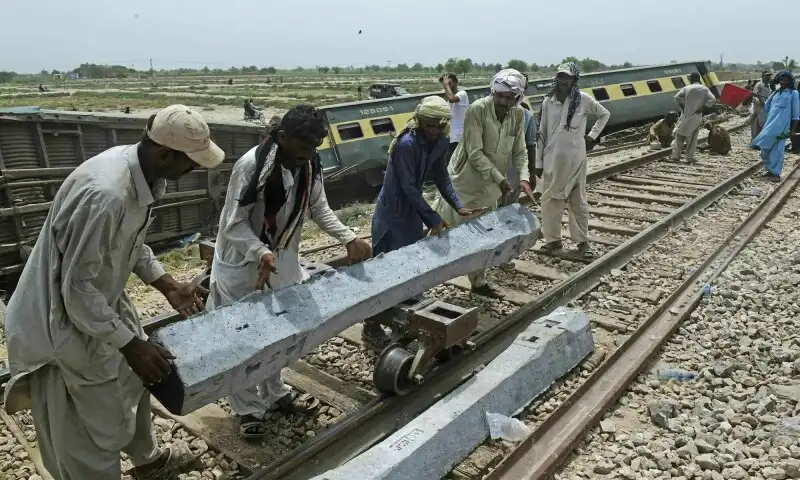The preliminary report of the departmental investigation into the derailment of the Hazara Express at Nawabshah, which resulted in the unfortunate loss of at least 30 lives and numerous injuries on Sunday, attributes the incident to the absence of fishplates and a track that had sustained damage.
According to the study released on Monday by a six-member investigative team from Pakistan Railways, the disaster occurred as a result of a recently damaged rail and the absence of fishplates, after considering all relevant factors.
Additionally, the research team recognized the sliding of the train’s locomotive as an additional factor contributing to the occurrence of the crash.
According to the report, which was reviewed by Dawn, it is stated that the train engine departed from the location without undergoing inspection by higher-ranking subordinates. Furthermore, it was seen that there were small areas of impact on the iron fishplates and wooden terminal located beyond the site of the event. Therefore, the engineering branch and mechanical branch bear responsibility for this accident.
The engineering and mechanical sections of PR are being held accountable, with the possibility of sabotage not completely dismissed.
According to the study, the possibility of sabotage cannot be dismissed, given that the derailed coaches were pulled at a distance of 750 feet.
Two members of the team had conflicting opinions.
Expressing dissent with the findings, a member said, “The occurrence of the derailment can be attributed to the absence of two fishplates, a fractured rail, and the derailment of the engine within the track resulting from gauge spread.” As a consequence, the grazing marks were seen to be visible on the exterior of the wheel disc. Furthermore, there were no visible indications of heating on the track, fishplates, and bolts.
According to another dissenting authority, the primary factor contributing to the derailment was the jamming of the engine axle, which resulted in a significant displacement that caused impact marks on the fishplates. According to the official’s remark, the depth of the issue escalated as a consequence of ongoing jamming, leading to the breakage of fish bolts associated with the absent fishplates.
During the conversation with Dawn, a public relations representative stated that the current report under consideration is in its preliminary stages, and the final report will require further time for preparation.
An extensive investigation is currently being conducted by the Federal Government Inspector of Railways, a high-ranking officer at the grade 22 level, who is present at the location to ascertain the cause of this tragic incident.
Track upgrade under CPEC
On Monday, the site of the incident was inspected by the inquiry team, led by FGIR Ali Mohammad Afridi. The track forms an integral component of Pakistan’s primary railway network, which is slated for enhancement as part of the China-Pakistan Economic Corridor.
In a conversation with Dawn, Mohsin Siyal, the Divisional Commercial Officer of PR in Sukkur, stated that as of now, no measures of disciplinary nature have been taken against any personnel.
Various individuals on social media platforms were disseminating a series of photographs depicting fragmented sections of railway tracks, along by assertions that these compromised rails were responsible for the catastrophic train accident.
The image appears to be a photograph taken after the occurrence of an incident. If the engine had experienced a malfunction prior to the occurrence and was deemed a potential factor in the catastrophe, it is highly likely that the engine would have derailed initially. Additionally, a public relations official, who preferred to remain anonymous, stated that wood is a component of the entire rail system.
Nevertheless, he noted that it would be premature to provide any commentary on the underlying factors that led to the occurrence of the disaster.
Delays
Despite the fact that PR managed to repair one track by 4 am on Monday, the impact on traffic was still significant.
According to an official, the resumption of the voyage for a down-country train is signaled after two upcountry trains have been let to pass via the track.
The trains are being halted at several stops due to a lack of clearance since the process of permitting trains to traverse the single track consumes a significant amount of time.
As to another authoritative source, the track in the vicinity of Sarhari experienced inundation as a result of substantial precipitation during the previous year, compounded by the discharge of rainwater from adjacent regions in close proximity to the track.
The individual emphasized that the railway remained unaffected and resumed normal operations in September of the previous year.
As per the statement provided by Dr. Riaz Umrani, the deputy medical superintendent of Peoples Medical University Hospital Nawabshah, a total of 27 bodies have been released to their respective heirs, while three bodies remain stored in the cold storage facility. According to his statement, a total of 21 individuals who were injured were under medical care till Monday afternoon.
‘Waiting to happen
The occurrence of the deadly crash on Sunday, however, is not unexpected when considering a two-year-old official report.
In a correspondence addressed to senior officials in the year 2021, Mian Tariq Latif, a former DS Sukkur Railway, expressed concerns regarding the deteriorated state of tracks within the Sukkur Division. Latif highlighted various issues including widespread loose and weak joints, track jolts, significant gaps, missing fishplates, and joint bolts, as well as the identification of over 6,000 hazardous joints along the main line.
It is worth mentioning that a higher number of derailment incidents have been observed in the Sukkur Divisions compared to other regions. This can be attributed to the deteriorating condition of the railway tracks spanning from Sukkur to Sibi, as well as from Sukkur to Liaquatpur.
The individual had requested a minimum of five welding teams, as opposed to the single team now available, which has the capacity to weld only six joints within a day.
Shortly following Mr. Latif’s correspondence, a tragic incident occurred at Rwanti train station resulting in the unfortunate demise of 62 individuals.
